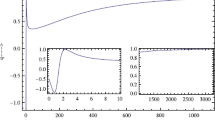Abstract
If we assume that the constants of nature fluctuate near the singularity when a black hole forms (assuming, also, that physical black holes really do form singularities) then a process of evolution of universes becomes possible. We explore the implications of such a process for the origin of life, interstellar travel, and the human future.
Similar content being viewed by others
References
Crane, L. (1992). Topological quantum field theory as the key to quantum gravity. In Proceedings of conference on knot theory and quantum gravity, Riverside Ca.
Crane, L., & Westmoreland, S. (2010). Are black hole starships possible, to appear, http://arxiv.org/abs/0908.1803
Smolin L. (1998) The life of the cosmos. Oxford University Press, New York
Author information
Authors and Affiliations
Corresponding author
Rights and permissions
About this article
Cite this article
Crane, L. Possible Implications of the Quantum Theory of Gravity: An Introduction to the Meduso-Anthropic Principle. Found Sci 15, 369–373 (2010). https://doi.org/10.1007/s10699-010-9182-y
Published:
Issue Date:
DOI: https://doi.org/10.1007/s10699-010-9182-y




